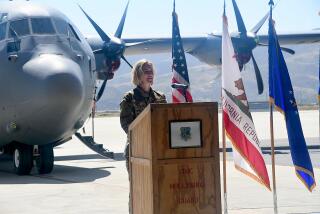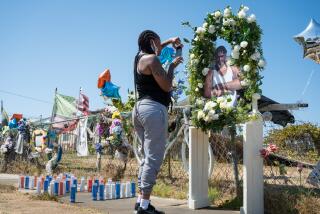Soldiers Detail a Mission Gone Wrong
- Share via
The sun rose over central Iraq as the soldiers, searching for weapon stashes, trudged past a bombed-out police station and through shoulder-high fields of wheat, lugging M-16s, mine detectors and grenades. Sometimes they fell, stumbling over large clumps of dirt turned up by farmers. Sometimes they talked about dying; they had been sent, in the detached vernacular of the military, to a place that was “not friendly.”
Most often, though, they cursed and complained; their mission had begun at 3 a.m., on little sleep, with no breakfast. Before long, it was already 100 degrees. They had been paired with trainees from the Iraqi national guard, who were falling behind. A lieutenant was learning how to say “keep up” in Arabic when the gunfire began.
It has been two years since that morning, since two California Army National Guard soldiers -- Spc. Patrick R. McCaffrey Sr., 34, of Tracy and 1st Lt. Andre D. Tyson, 33, of Riverside -- were killed.
Late last month, military officials gave the families of the soldiers more than 200 pages of documents outlining their investigation of the killings. The documents confirmed what the soldiers’ families had long suspected -- that McCaffrey and Tyson were killed not by insurgents, as the military initially had reported, but by their purported allies, the very Iraqis whom they had trained to fight.
Tyson’s family has decided not to speak publicly. But McCaffrey’s parents have become outspoken critics of the White House and continue to raise questions -- about the killings, and about whether the military attempted to suppress the truth because it could have further soured public opinion about the war. The military has said there was nothing improper about its handling of the case.
On June 22, 2004, McCaffrey and Tyson, who had arrived in Iraq two months earlier, were conducting a patrol near the town of Balad, about 50 miles north of Baghdad.
The summer had already turned tense and traumatic. According to a witness account written by an American soldier the day of the attack and included in the documents, six rockets had struck the soldiers’ base, called Camp Anaconda, a week earlier. One rocket had landed on the PX, the general store common to many military installations, and killed two soldiers.
At 11 p.m. on June 21, commanders announced that soldiers from the base would be participating in a mission to check eight dangerous areas for weapons stashed by insurgents. The mission would begin four hours later.
“No one had gotten much sleep,” wrote one soldier, whose identity, like almost all in the documents, was kept private by the military. “The areas we walked through were dense jungle. The ground isn’t flat and there are small canals every 25 ft.... We’re walking through brush neck high, trying to keep our footing, and hoping our next step doesn’t land us ... in a canal. ‘It’s like being in Vietnam’ is the running joke.”
By late morning, they were “tired and starving,” another soldier wrote. They had marched for more than five hours without food. Their feet were in agony, their nerves raw from fear of snipers and drive-by shootings, the documents say. Medics had given intravenous fluids to at least two soldiers who were experiencing heat exhaustion. In one witness account, one officer said he was careful not to reveal his extreme fatigue “so my group won’t lose their motivation to carry on the mission.”
Soon, the Americans met up, as planned, with 12 members of the Iraqi national guard whom they had recently trained. (The guard was known at the time as the Iraqi Civil Defense Corps, or ICDC.)
This was not a welcome addition to the patrol, the documents suggest. It wasn’t long, the documents say, before the Iraqi soldiers were complaining too: that the American soldiers were looking for weapons caches in the wrong areas, that the water they had been given to drink was too warm.
“I’ve heard on the news that they’re more than ready to take over after we’ve left,” the first soldier wrote. “But from what I’ve seen, they couldn’t be more wrong. For the last two weeks, our ‘off’ days have been spent baby-sitting.”
The patrol was soon split into two, a decision that mystified some soldiers, who felt it left them dangerously exposed, according to the documents.
“They’re not going to stop pushing us until someone gets hurt or killed,” McCaffrey told fellow soldiers, according to witness accounts in the documents. “Then maybe they’ll let up.”
“That was the last thing I remember him saying,” a soldier wrote in his account.
It is unclear how many Americans and how many Iraqis were in each group: One investigative document says Tyson and McCaffrey’s group included three U.S. soldiers and four or five ICDC soldiers; another account says 12 Iraqi soldiers were present.
McCaffrey and Tyson’s group wound up on a narrow road near Bakr village. The attack began when they stopped briefly, next to a mud wall, so that Tyson could use the radio that McCaffrey had begun carrying after another American soldier faltered in the heat. The bullets started flying.
Tyson was shot in the head, just above the left eye, with an AK-47, according to the documents. McCaffrey was shot in the torso. When soldiers from nearby patrols, including some members of the group that had splintered from the one Tyson and McCaffrey were in, swept to the scene minutes later, Tyson was trying to breathe, the documents say, but he would not live long. An American soldier approached McCaffrey’s body.
“They said not to worry about him,” one soldier reported in a witness account. “He’s dead.”
The military initially told the soldiers’ families that the men had been ambushed by insurgents. But in late June, the military informed the families that McCaffrey and Tyson were actually killed by members of the Iraqi national guard who were on patrol with them.
It remains unclear how many people participated in the attack. One Iraqi trainee is in custody awaiting prosecution, said Army officials, who have not identified the suspect. The Army has not discussed the alleged motives of the suspect or others who may have taken part in the attack.
The military, acknowledging a nine-month lapse between the conclusion of the criminal investigation and the family briefings, attributed that delay to the “complexity of the case.”
The incorrect explanation for the attack, the Army said, was “based on the preliminary casualty report.”
But according to one witness account in the documents, a soldier who survived the attack told his rescuers -- even before he had been moved from the ditch where he landed after the attack -- that “the ICDC shot him.”
Another document shows that an Iraqi soldier who witnessed the attack quickly identified one of his colleagues as a shooter. Within a day, military investigators were developing a detailed profile of that suspect’s life; interviews indicated that he was “temperamental” and “regards himself as a hero,” the documents show.
A third document shows that American soldiers who rushed to the scene after the attack learned within hours that the assailants were wearing Iraqi uniforms. The U.S. soldiers also had a list of missing Iraqi soldiers written in English and Arabic and were talking to a local sheik to try to find them.
Those details have fueled suspicions among the California soldiers’ relatives that the military shaded the truth to keep the public from learning that Iraqi soldiers had turned on their American trainers. That knowledge, the critics have said, could have damped public support for the war.
“You’d like to give them the benefit of the doubt. But it really makes one incredulous. It’s just one continuous lie,” said Bob McCaffrey of Redding, Calif., the father of Patrick McCaffrey.
“They took a head count within an hour. They knew exactly who was responsible, who these damn guys were. Why would they then release a false report -- and that’s what it was, a false report -- other than to save face and not put their public relations campaign in danger?”
A military official, speaking on condition of anonymity, said the documents were released only last month because it had “not come to the attention of the Family Notification Unit until recently that the family had not been given a formal briefing.”
Army spokesman Paul Boyce agreed that U.S. soldiers “did have a suspicion immediately” that Iraqi soldiers were behind the attack. But, he said, “it had to be investigated.”
In the first hours and days after the attack, Boyce said, “there was some confusion as to who was shooting at the soldiers and from what vantage point.”
According to the documents, there were conflicting accounts among American soldiers, for example, of the number of attackers and the number of ICDC soldiers who had joined with the Americans in the first place. While those discrepancies were being investigated, Boyce said, the Army concluded that the attack was an ambush by insurgents.
“That was what was passed on to the family,” Boyce said. “The suspicion was that it was some kind of enemy attack.”
More to Read
Sign up for Essential California
The most important California stories and recommendations in your inbox every morning.
You may occasionally receive promotional content from the Los Angeles Times.











